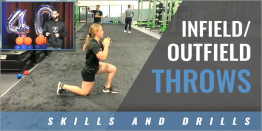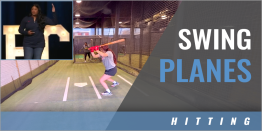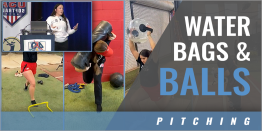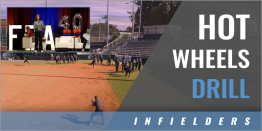| Drills to Help Catchers Reinforce Their Skills |
| By: Jo Clair - Founder, Protect the Plate
Originally Published in: FastPitch Delivery Provided by: NFCA In my January article, I challenged you to find ways that work within your current framework to get your catchers the specific practice and development they need during the 2018 season. Now that you've carved out some practice time for your catchers, it's time to create the workouts that reinforce efficient movement patterns for fundamental skills. During a game, there are many things for which a catcher is responsible. As a coach, I want my catcher focused on their pitcher and directing traffic in the game. I do not want them thinking about moving from one stance to another, their blocking position, or their footwork during throwing. I want these basic movement patterns to be learned and ingrained during practice, so that they can manage the emotions of the pitcher and team during the game. In this article, I have outlined the meta-goal, as well as a sample progression for each of the foundational skills of catching. The purpose of the progression is to reinforce the basic movement patterns that are required of each skill, so that over time these patterns become second nature to the catcher. Stances Goal: Quiet and efficient movement between all three stances. To accomplish this: The most effective tool in teaching and coaching is a mirror because it doesn"t lie. Start by having catchers use a mirror to view themselves in each of their three stances: pitch-calling, receiving, and active (runners-on) stance. Continue by having catchers move through their pre-pitch movement routine: move from giving a sign, to setting up for a location, to actively preparing as that pitch is being received. Many coaches will use video to record live at-bats in practice. Using that footage, carve out a few minutes out to review it with the catchers; however, focus your attention on them, instead of what occurred with the hitter. In looking at them, here are a few questions to ask: Are their signs visible to the pitcher, but hidden from the rest of the field? How is their movement related to that of the pitcher? Are they moving too early or too late? Is their target at the correct height? Are they quiet behind the plate? Framing Goal: Increase number of borderline strikes by receiving pitch quietly in proper position. To accomplish this: Start by having catchers receive tennis balls on their knees. The focus in this simple drill is three-fold: 1) catch the ball out in front of the body, 2) receive with the proper wrist action, given the location of the pitch, and 3) work to get center of the body behind the ball. Continue sequence by 1) alternating between a tennis ball and a weighted ball, 2) receiving with a wrist weight, and 3) receiving with a small Wiffle ball placed in palm of hand, so that catchers focus on receiving with their thumb, index and middle fingers. To increase difficulty, use a marker to write numbers in different colors on the tennis balls. Have catchers say the number or color out loud upon receiving the ball. Progress toward using glove and real ball, with a continued focus on correct movement patterns. To simulate game-like speed and increase repetitions, use a pitching machine to have catchers work on framing different locations, which can be done either on their knees or in their receiving stance. Blocking Goal: Using hockey goalie mentality, be fearless in use of body to keep ball in front by “creating a cave” that will reduce movement of the ball post-contact. To accomplish this: To get catchers focused on “creating a cave” with their bodies, start by having catchers on their knees to practice the movement of turning the glove over from a receiving position out in front to a blocking position between their knees. Continue sequence by throwing short-hops to them using foam or real balls. The goal of the tosser is to beat the catcher between the legs. The goal of the catcher is to turn their glove over as the ball is coming to plug the hole between her legs and move her hips backward, which will “create the cave.” With more practice, catchers will learn how to soften their body, so that the moving ball lands directly in front of them. To increase difficulty, create a short hop with a pitching machine to simulate game-like speed. For added challenge, place cones in a small semi-circle around the catcher to provide a visual aid of where ball should land post-contact with body. Using a similar progression, have catchers work from receiving stance to blocking position. Place a cone behind each foot so that the catchers can see their feet kicking backward and their knees ending where their feet started. Start with short hops, progress toward a pitching machine, and end with tracking the number of blocks during a bullpen session. Transfers & Throwing Footwork Goal: Quick and efficient movement patterns for transfers and footwork. To accomplish this: Start by separating transfer drills and footwork drills. To begin work on transfers, have catchers on their knees receiving tennis balls with their bare hands. The focus should be on creating a quick, efficient movement from glove hand to throw hand, resulting in a clear separation of the hands. To continue the sequence, have players receive with a flat glove and then a real glove. All of these drills should be done from their knees to simplify the movement required and reinforce that their focus should be on creating a quick and efficient transfer. To begin work on footwork, set up cones in the shape of a T to guide catchers in getting their feet where they need to be. Start by having catchers work with a medicine ball to reinforce movement pattern from an active receiving stance to their throwing position. To continue the sequence, have catchers start with a ball in their glove to focus on their timing of making a transfer before their feet move into proper alignment. To increase difficulty, time how long it takes for them to move from their stance to their throwing position 10 times, or add in footwork to different bases to simulate pick-off throws. Once a player has established efficient movement patterns with their transfers and footwork, use a sequence that demands them to put these skills together by first making the transfer and then getting their feet into proper alignment immediately after. For example, start with a tennis ball toss, progress to a real ball toss, and finally, challenge them using a pitching machine. Depending on the amount of space, the last step is for the catchers to actually make a throw to all of the different bases. To summarize, efficiency is the key. To be efficient, catchers must practice the basic movement patterns that are required of them in every game. As coaches, if we carve out time for them to reinforce these skills during practice, it will allow them to focus their energy on the pitcher, being vocal, and directing traffic amongst the defense during the game. |







